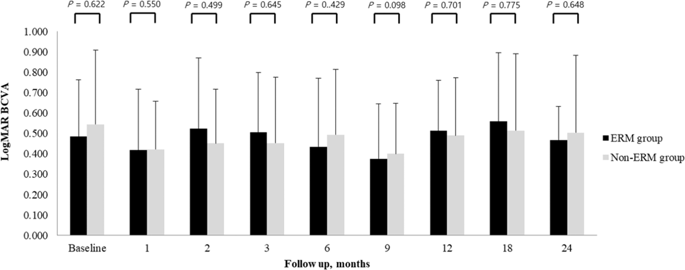Our official English website, www.x-mol.net, welcomes your
feedback! (Note: you will need to create a separate account there.)
Incidence and treatment outcomes of secondary epiretinal membrane following intravitreal injection for diabetic macular edema.
Scientific Reports ( IF 3.8 ) Pub Date : 2020-01-17 , DOI: 10.1038/s41598-020-57509-6 Yong Koo Kang 1 , Han Sang Park 1 , Dong Ho Park 1 , Jae Pil Shin 1
Scientific Reports ( IF 3.8 ) Pub Date : 2020-01-17 , DOI: 10.1038/s41598-020-57509-6 Yong Koo Kang 1 , Han Sang Park 1 , Dong Ho Park 1 , Jae Pil Shin 1
Affiliation

|
The purpose of this study was to investigate the incidence of secondary epiretinal membrane (ERM) after intravitreal injection and the effect of ERM on visual acuity and central macular thickness (CMT) in patients with diabetic macular edema (DME). We included 147 eyes of 95 patients over 18 years old who were diagnosed with DME from 2012 to 2016, treated with intravitreal injection, and followed-up more than 24 months. Mean CMT in the ERM group was significantly thicker than in the non-ERM group after 9, 12, 18, and 24 months. Secondary ERM developed in 9.5% of patients during follow-up. Compared to other agents, the incidence of secondary ERM was significantly higher after intravitreal injection of dexamethasone implant. Among patients in the ERM group, the mean decrease of CMT between pre-injection and 2 weeks post-injection was significantly less after secondary ERM formation than before ERM formation. Secondary ERM formation was significantly associated with the number of intravitreal injections and the use of dexamethasone implant. Therefore, secondary ERM develops more frequently as the number of intravitreal injections increases and after intravitreal dexamethasone implant injection. The therapeutic effects of intravitreal injections for DME patients decrease after secondary ERM formation.
中文翻译:

玻璃体内注射治疗糖尿病性黄斑水肿后继发性视网膜前膜的发生率和治疗结果。
这项研究的目的是调查玻璃体内注射后继发性视网膜前膜(ERM)的发生率以及ERM对糖尿病性黄斑水肿(DME)患者视敏度和中央黄斑厚度(CMT)的影响。我们纳入了2012年至2016年诊断为DME并接受玻璃体内注射治疗且随访超过24个月的95岁以上18岁患者的147只眼睛。在9、12、18和24个月后,ERM组的平均CMT明显高于非ERM组。随访期间9.5%的患者发生了继发性ERM。与其他药物相比,玻璃体腔注射地塞米松植入物后继发ERM的发生率明显更高。在ERM组的患者中,二次ERM形成后,注射前和注射后2周之间CMT的平均下降明显少于形成ERM之前。继发性ERM的形成与玻璃体内注射的次数和地塞米松植入物的使用显着相关。因此,随着玻璃体内注射次数的增加以及玻璃体内地塞米松植入物注射后,继发性ERM的发生更加频繁。继发性ERM形成后,玻璃体内注射对DME患者的治疗效果下降。随着玻璃体内注射次数的增加以及玻璃体内地塞米松植入物注射后,继发性ERM的发展更加频繁。继发性ERM形成后,玻璃体内注射对DME患者的治疗效果下降。随着玻璃体内注射次数的增加以及玻璃体内地塞米松植入物注射后,继发性ERM的发展更加频繁。继发性ERM形成后,玻璃体内注射对DME患者的治疗效果下降。
更新日期:2020-01-17
中文翻译:

玻璃体内注射治疗糖尿病性黄斑水肿后继发性视网膜前膜的发生率和治疗结果。
这项研究的目的是调查玻璃体内注射后继发性视网膜前膜(ERM)的发生率以及ERM对糖尿病性黄斑水肿(DME)患者视敏度和中央黄斑厚度(CMT)的影响。我们纳入了2012年至2016年诊断为DME并接受玻璃体内注射治疗且随访超过24个月的95岁以上18岁患者的147只眼睛。在9、12、18和24个月后,ERM组的平均CMT明显高于非ERM组。随访期间9.5%的患者发生了继发性ERM。与其他药物相比,玻璃体腔注射地塞米松植入物后继发ERM的发生率明显更高。在ERM组的患者中,二次ERM形成后,注射前和注射后2周之间CMT的平均下降明显少于形成ERM之前。继发性ERM的形成与玻璃体内注射的次数和地塞米松植入物的使用显着相关。因此,随着玻璃体内注射次数的增加以及玻璃体内地塞米松植入物注射后,继发性ERM的发生更加频繁。继发性ERM形成后,玻璃体内注射对DME患者的治疗效果下降。随着玻璃体内注射次数的增加以及玻璃体内地塞米松植入物注射后,继发性ERM的发展更加频繁。继发性ERM形成后,玻璃体内注射对DME患者的治疗效果下降。随着玻璃体内注射次数的增加以及玻璃体内地塞米松植入物注射后,继发性ERM的发展更加频繁。继发性ERM形成后,玻璃体内注射对DME患者的治疗效果下降。











































 京公网安备 11010802027423号
京公网安备 11010802027423号